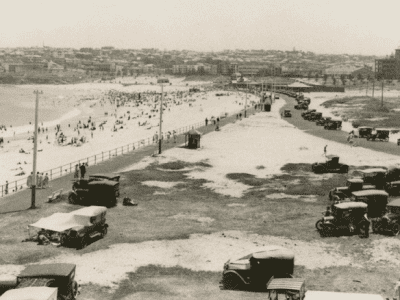My Happy Beach is Bondi

Bondi from the north end looking down the beach back toward the Bondi Hotel. Photo circa 1924
My father was a Manly boy, but mother came from Bondi. Fortunately for me they made a wise choice and moved to the Eastern Suburbs of Sydney. This meant I followed my mother’s family and the beach of childhood was Bondi. Here my grandfather was one of the early Bondi Icebergs and cousins joined Bondi Surf Club. I learnt to swim in Bondi Baths and to body surf those gorgeous waves of youth.
Caroline Ford in her recent book on Sydney beaches tells many stories of Bondi going back before settlement including the battles to secure public ownership. I have examined old photos and records and find the history of use of the beach and adjoining dunes illustrative of much of colonial and post-colonial transformation of coastal landscapes in Sydney and beyond. High stable then mobile transgressive dunes came and went, promenades were built along with pavilions and surf clubs. Debates have raged for 150 years over access and transport to Bondi and it hasn’t stopped.
Concrete groynes were built onto the beach between the wars then blown up by the Sydney University Regiment during World War 2 damaging windows across Campbell Parade.
The Olympic volley ball site on the beach caused much local angst; claims were made that it would destroy our precious beach forever so it was pulled down at lightning speed with no noticeable effect on the beach. Manly wanted these games, but their site was rejected. Bondi had to put up with them because of access, status, transport and the majestic nature of the wide clean sand.
One of the greatest gifts given to Bondi is the location of the wall that forms the promenade. It was located far enough back from the daily movement of tides and waves to not affect beach width. I can only recall the June storm of 1974 damaging the wall after beach sand had been swept seaward during the preceding massive May storm of that horrendous year. Even the foundations of the old groynes were exposed at this time. But the sand returned. Bondi is a wonderful example of a resilient, closed sediment compartment . Medium to fine quartz sand with very little shell is locked up within the bay to be shunted back after each major storm event. Periods of relative calm lead to the building of a wide beach berm forming a soft sand platform for beach lovers. Rip cells and wave breaks add to the drama of surfing along with the crowds.
Bondi has had its share of dramas. Many have been saved from drowning but sadly many die in the surf and even on the beach at Bondi. Pollution has also been damaging to its reputation. Sydney Water long resisted attempts to relocate sewer outfalls offshore. Sydney Coastal Councils Group spurred on by Waverley Council worked tirelessly to overcome this scourge of the coast. Sharon Beder wrote a fascinating book called Toxic Surfing outlining the dramas of this time. Now the beach has returned from this extremely sad state to its present condition.
Today my enjoyment of Bondi is more from learning and watching rather than active surfing. I have absorbed its history thanks the Council library staff, Sharon Beder, Caroline Ford and another historian, Doug Booth. I think I understand its geomorphology and coastal processes and revel in any opportunity to expose my knowledge to questioning visitors from interstate or overseas.
Looking at tourists swarm over the promenade tells me we have an international icon to protect despite all the traffic and noise. So many uses are made of the water, the beach, the promenade, the pavilion and the park that Council is facing many management challenges. But I also love to see my grandkids amongst the waves following the footsteps of their great, great grandfather.
– words by Prof Bruce Thom


 Coastal Dune Weeds
Coastal Dune Weeds